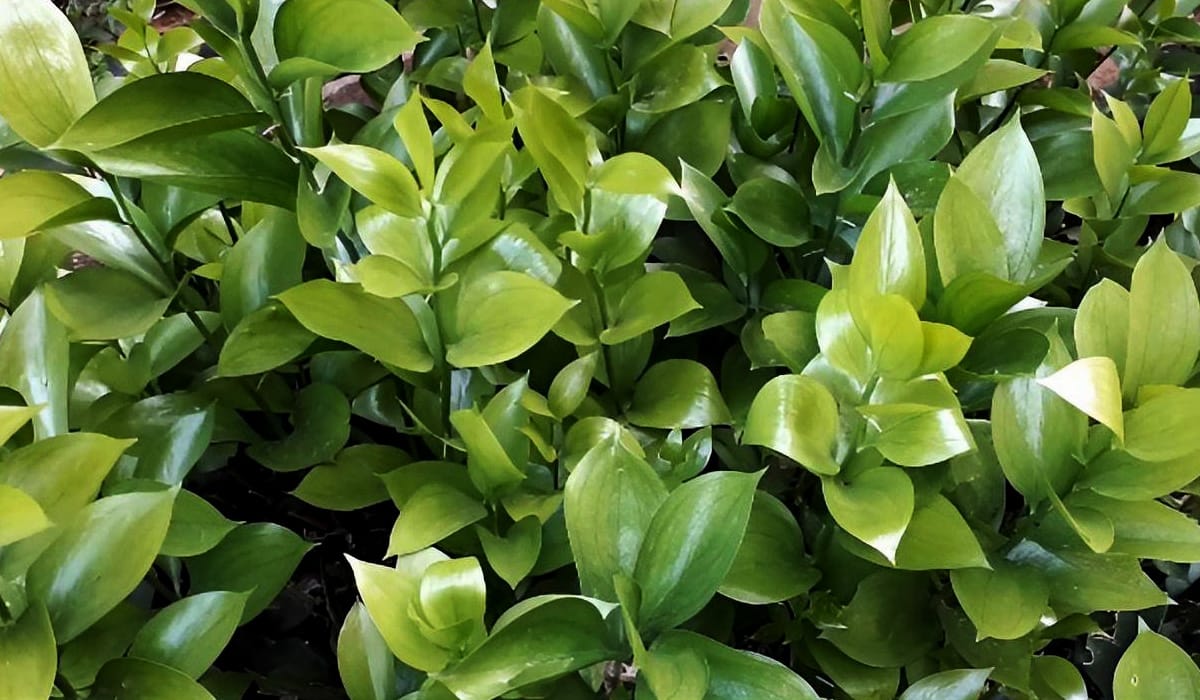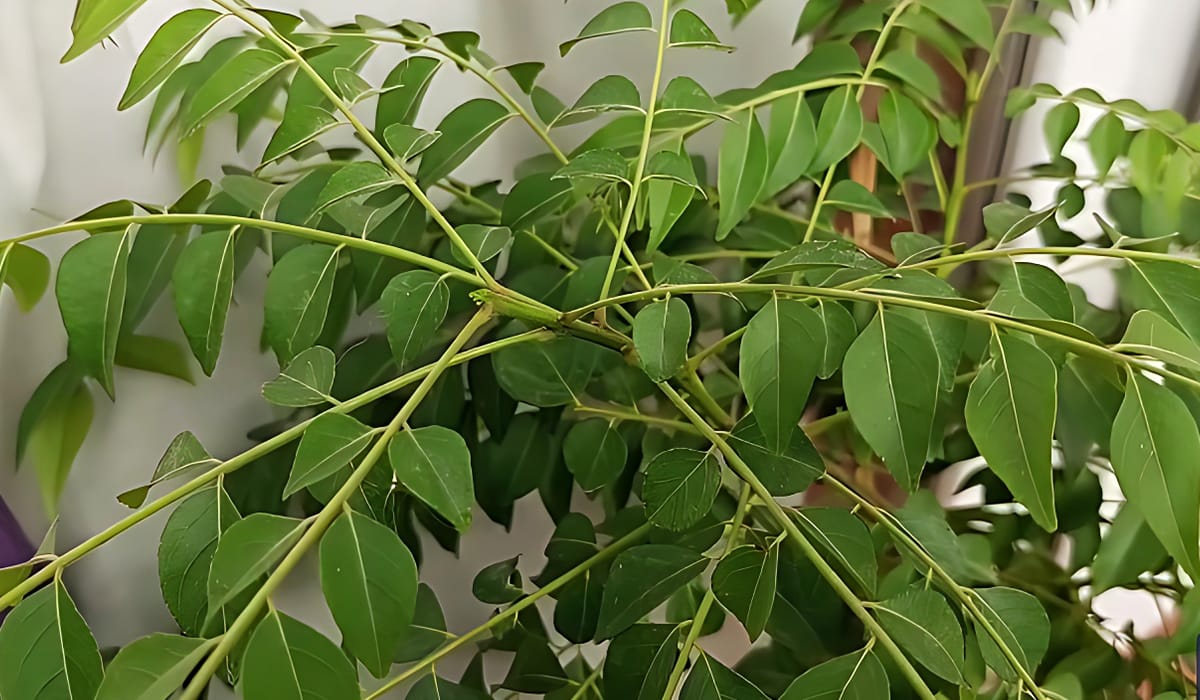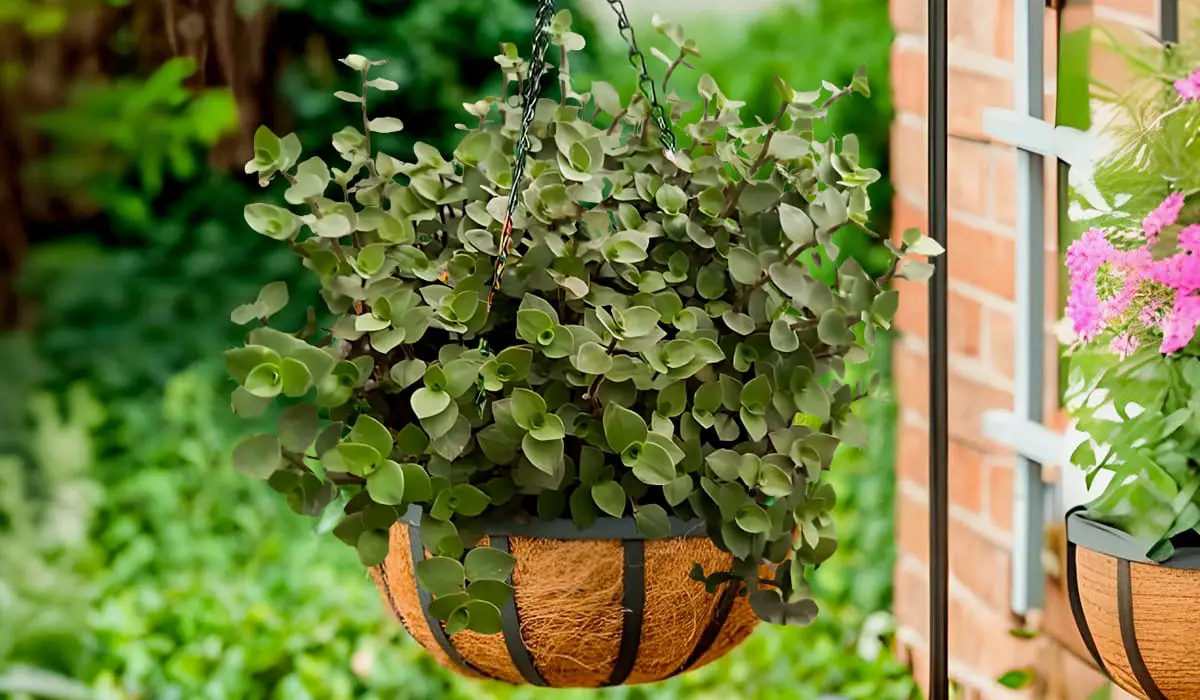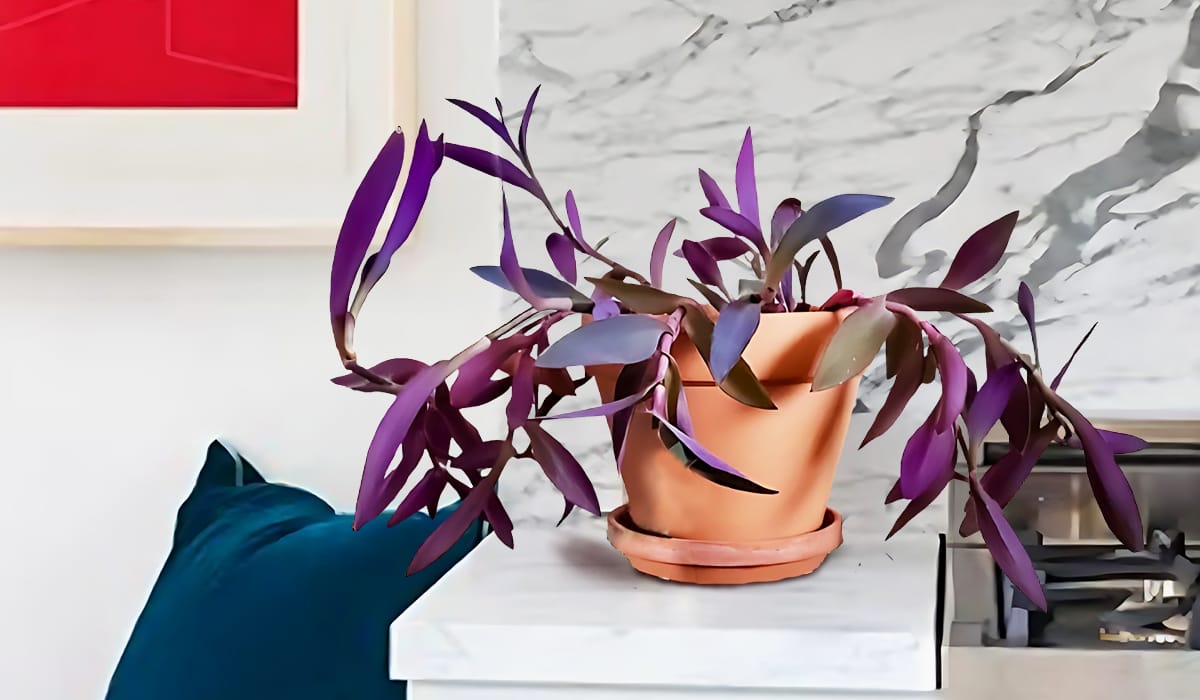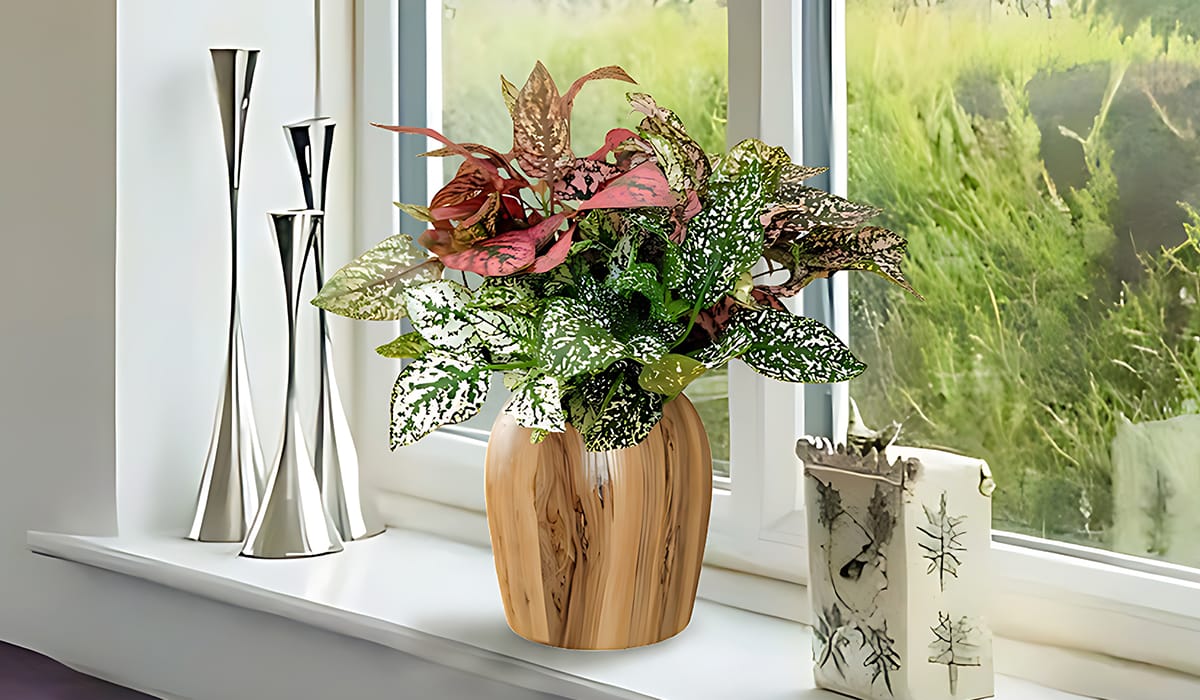Are you looking a good Pothos plant and if You searching, how to plant, grow, and care for Pothos plants?
Great You have come to one of the best resources available on the internet.
We researched several books, blogs, and videos about the Pothos plant and added our personal experiences then we wrote this article. If you read this full article properly. Then you will get a complete idea of the Pothos plants and care of them. So if you are a plant lover we hope you will enjoy this article.
let's Introduce
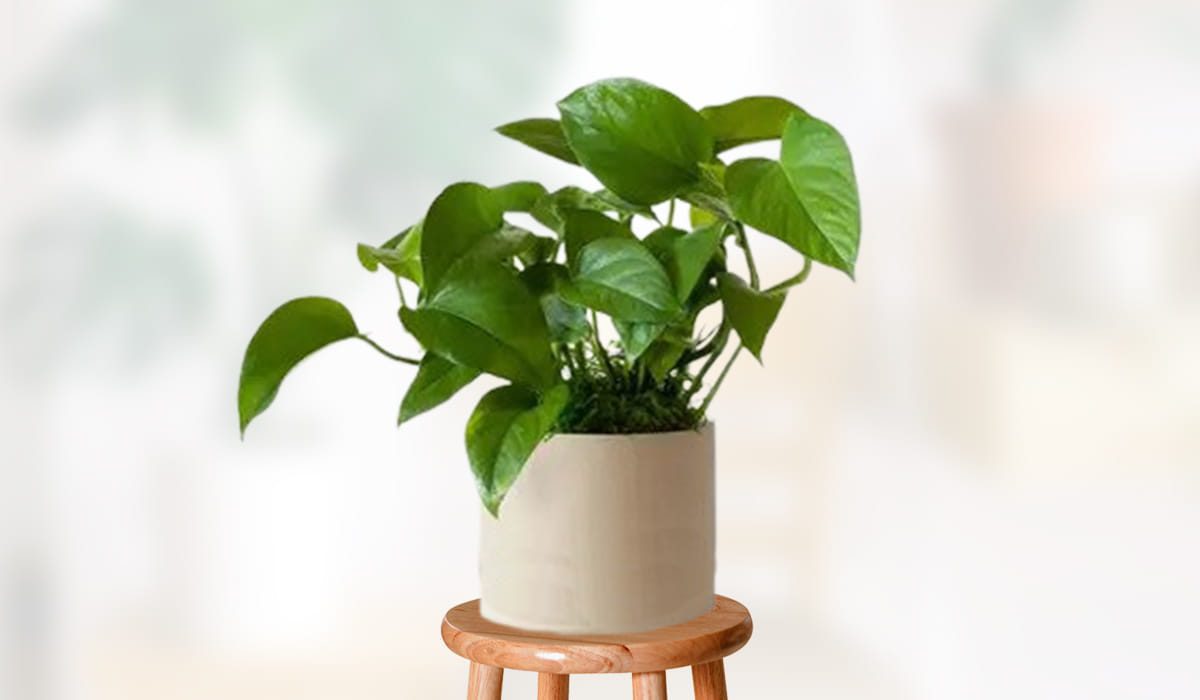
Pothos plant
Few can match the versatility and beauty of the Pothos plant. With its vibrant green foliage and easy-care requirements, it has become a favorite among both seasoned plant enthusiasts and beginners alike. In this comprehensive guide, we will delve into the world of Pothos plants, exploring everything from their origins and varieties to the essential aspects of Pothos plant care. Whether you're a seasoned indoor gardener or just starting your journey, by the end of this article, you'll be equipped with the knowledge to ensure your Pothos plants flourish. You can collect it from any nursery or online.
| Common Name: | Pothos |
| Botanical Name: | Epipremnum aureum |
| Height: | Typically grows up to 6-10 feet in indoor settings. |
| Tolerate: | Pothos plants are known for their tolerance to low light and neglect. |
| Plant Type: | Perennial, evergreen vine. |
| Family: | Araceae |
| Sun Exposure: | Pothos prefers bright, indirect light but can tolerate low light conditions. |
| Mature Size: | Varies, but can spread several feet. |
| Soil pH: | Thrives in slightly acidic to neutral soil (pH 6.1 - 7.5). |
| Soil Type: | Well-draining potting mix. |
| Flower Color: | Rarely flowers indoors; flowers are greenish-white. |
| Bloom Time: | Blooms are infrequent in indoor settings. |
| Native Area: | Southeast Asia, including countries like Malaysia, Indonesia, and the Philippines. |
| Toxicity: | Considered mildly toxic to pets and humans if ingested. |
| Hardiness Zones: | Typically grown as a houseplant, not suited for outdoor planting in most regions. |
How to propagate Pothos plants

Propagating Pothos plants is relatively easy and can be done through several methods. Here are some common techniques for propagating Pothos:
1. Stem Cuttings

| Materials Needed: |
|---|
| Healthy Pothos plant |
| Pruning shears or scissors |
| Small pots or containers |
| Well-draining potting mix |
| Water |
- Select a healthy Pothos plant with long vines that you want to propagate.
- Using smooth pruning shears or scissors, reduce a wholesome vine simply under a leaf node. A leaf node is a small bump on the stem where leaves and roots grow.
- Cut the vine into sections, with each section containing at least one leaf node. You can typically get several cuttings from one long vine.Allow the cuttings to air dry for some hours. This helps the cut ends callus over, which reduces the risk of rot.
- Plant each cutting in a small pot filled with well-draining potting mix. Insert the cutting into the soil, making sure the leaf node is buried while the rest of the cutting is above the soil.
- Water the newly planted cuttings very well and vicinity them in a vicinity with bright, oblique light.
- Keep the soil continually wet however now no longer waterlogged. You can cover the pots with a plastic bag or use a propagation tray to create a humid environment, which can promote root development.
After a few weeks to a couple of months, you should start to see new growth and roots forming on the cuttings. Once they have established roots and are growing well, you can transplant them into larger pots or share them with friends and family.
2. Water Propagation
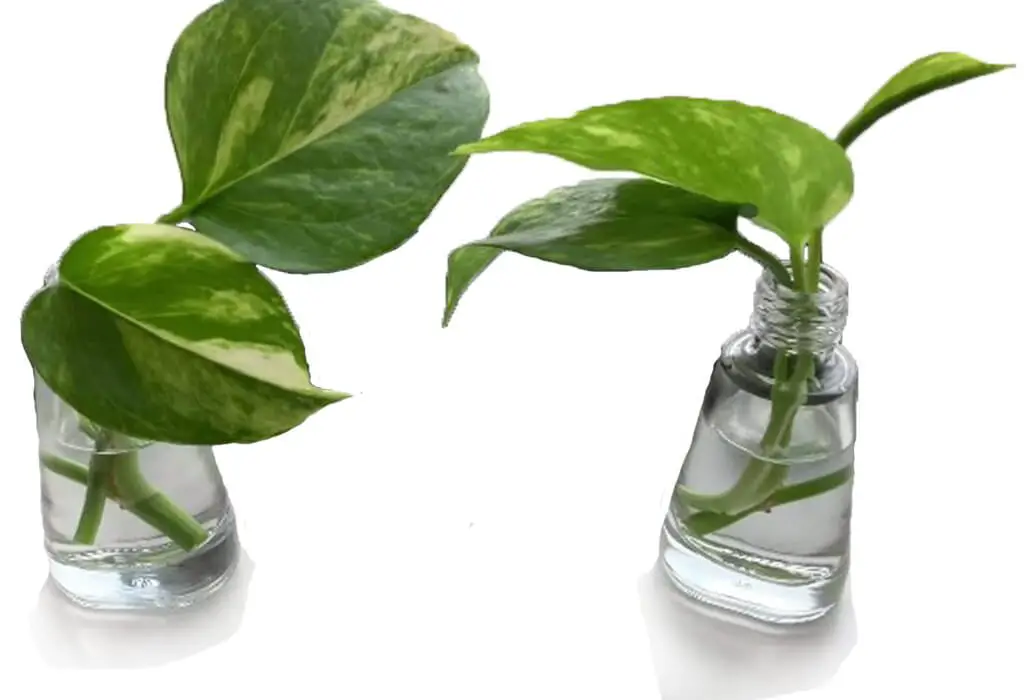
| Materials Needed: |
|---|
| Healthy Pothos cuttings (as prepared in the first method) |
| A glass or jar |
| Clean water |
- Take the Pothos cuttings as described in the stem cutting method.
- Place the cuttings in a glass or jar with enough clean water to submerge the nodes where roots will grow.
- Change the water every 1-2 weeks to keep it fresh and prevent rot.
- Keep the glass or jar in a area with bright, oblique light.
- In a few weeks to a couple of months, you should see roots growing from the nodes of the cuttings. Once the roots are a few inches long, you can transplant the cuttings into pots with well-draining potting mix.
Remember that Pothos is a relatively fast-growing plant, and with proper care, your propagated cuttings will develop into healthy, beautiful vines that you can enjoy in your indoor garden or share with others.
Pothos plants Care Tips

Caring for the Pothos plant (Epipremnum aureum) is relatively easy, making it an excellent choice for both beginners and experienced house gardeners. Here I give you a step-by-step guide on how to care for your Pothos plant:
1. Light Requirements:
- Pothos plants thrive in indirect or low light conditions. They can tolerate some degree of shade but should be kept away from direct sunlight, which can scorch their leaves. Place them in a spot with bright, filtered light for best results.
2. Watering:
- Allow the top inch (2.5 cm) of the soil to dry out before watering. Pothos plants are relatively drought-tolerant and prefer to dry out slightly between waterings.
- When it's time to water, thoroughly soak the soil, allowing excess water to drain out from the bottom of the pot. Empty the saucer beneath the pot to prevent water from sitting and causing root rot.
3. Temperature and Humidity:
- Pothos plants are adaptable to a wide range of temperatures but prefer consistent indoor temperatures between 65°F to 80°F (18°C to 27°C). Avoid exposing them to drafts or extreme cold.
- Maintain moderate humidity levels around the plant. If the air is too dry, consider using a humidity tray or a room humidifier to increase moisture in the air.
4. Pruning and Maintenance:
- Regular pruning can help keep your Pothos plant looking tidy and encourage bushier growth. Trim overgrown vines and remove any yellow or dead leaves using clean, sharp scissors or pruning shears.
5.Fertilization:
- Feed your Pothos with a balanced, water-soluble fertilizer diluted to 1/2 of power each 4-6 weeks at some stage in the developing season (spring and summer). Reduce or cease fertilization during the dormant winter months.
6. Repotting:
- Repot your Pothos when it becomes root-bound or outgrows its current container. You can tell it's time to repot when the roots start circling the pot's edges or when the growth becomes slow.
- Choose a slightly larger pot with proper drainage holes and fresh, well-draining potting mix. Repotting is typically done every 1-2 years.
7. Pest and Disease Management:
- Pothos plants are generally resistant to pests and diseases, but they can occasionally be affected by common indoor plant pests like spider mites or mealybugs. Inspect your plant regularly, and if you notice any issues, treat them promptly with appropriate measures like neem oil or insecticidal soap.
8. Support and Training:
- Pothos plants are natural climbers and can be trained to grow along a support structure like a trellis or moss pole. This can enhance their appearance and encourage upright growth.
With proper care and attention to these guidelines, your Pothos plant should thrive and continue to add beauty to your indoor space. They are forgiving plants that can tolerate occasional neglect, making them an excellent choice for busy plant enthusiasts.
Pothos plant Varieties

Golden Pothos Plant
- This is one of the most common and well-known Pothos varieties.
- Features heart-shaped leaves with vibrant green and yellow variegation.
- Adaptable and easy to care for, making it an excellent choice for beginners.
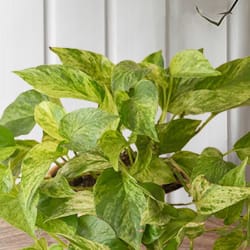
Marble Queen Pothos Plant
- Known for its strikingly marbled leaves.
- Leaves are predominantly green with prominent white variegation.
- Adds a touch of elegance to your indoor space.

Neon Pothos Plant
- Features bright, electric neon-green leaves.
- The vibrant color can liven up any room.
- Requires similar care to other Pothos varieties.
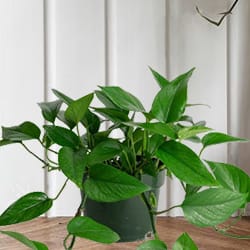
Jade Pothos Plant
- Known for its solid green leaves.
- Simpler in appearance compared to variegated varieties.
- Ideal for minimalist aesthetics.

Manjula Pothos Plant
- A relatively newer cultivar with uniquely patterned leaves.
- Leaves have silver, cream, and green variegation.
- Grows well in moderate light conditions.

Pearls and Jade Pothos Plant
- Features small white spots and silver streaks on green leaves.
- Compact growth habit makes it suitable for hanging baskets or small spaces.
- Moderate to bright indirect light is ideal.
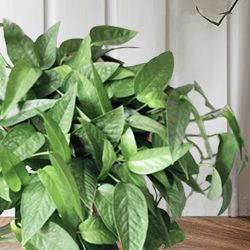
Cebu Blue Pothos Plant
- Distinctive for its silvery-blue leaves with a rippled texture.
- A unique and eye-catching Pothos variety.
- Thrives in bright, indirect light.
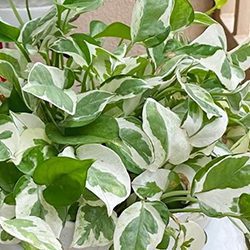
N'Joy Pothos Plant
- Known for its green leaves with cream-white stripes.
- Offers a balanced combination of variegation.
- Requires similar care to other Pothos varieties.

Satin Pothos Plant
- Often confused with Pothos, it's a related species.
- Features heart-shaped leaves with silver, satin-like texture.
- Prefers lower light conditions compared to traditional Pothos.
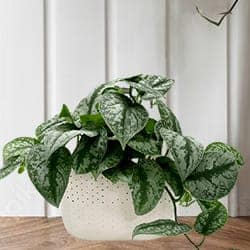
Silver Satin Pothos Plant
- Another relative of Pothos with silver-patterned leaves.
- Requires moderate to low light conditions.
- Ideal for homes with less natural light.
Common Pothos Plant Problems: And Solution
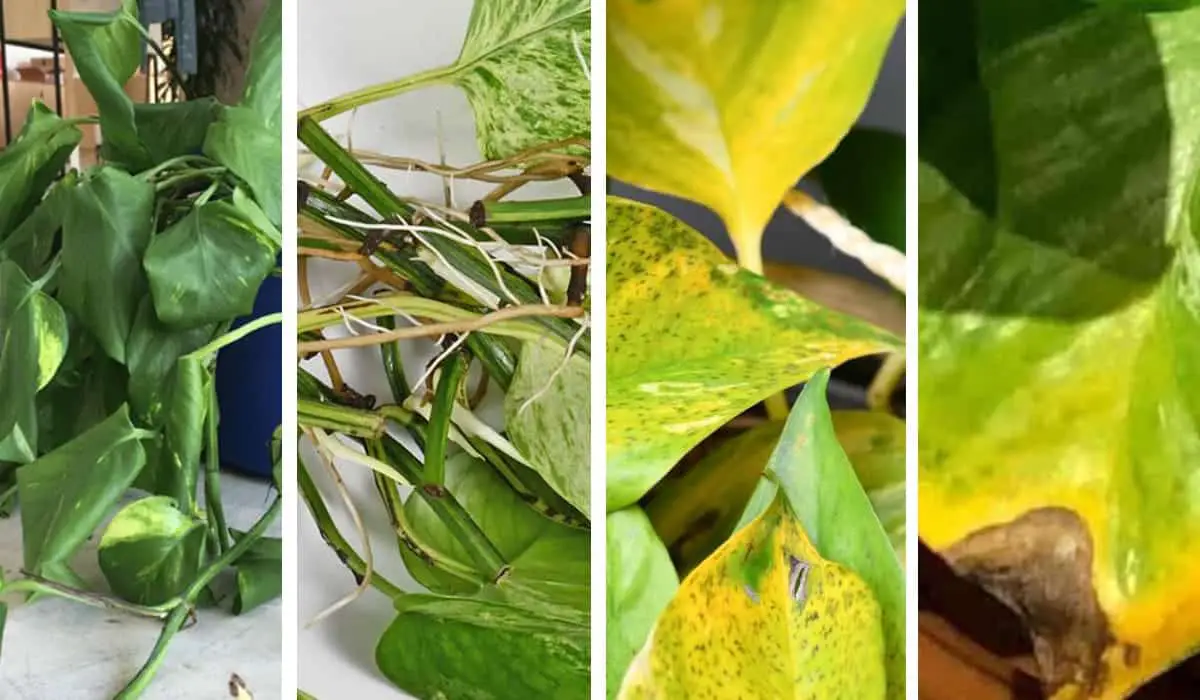
Pothos plants are generally hardy and resilient, but like all houseplants, they can encounter issues from time to time. Here are some common problems you might encounter with Pothos plants and their solutions:
1. Yellowing Leaves:
Problem: Yellow leaves on a Pothos plant can be caused by overwatering, underwatering, or poor drainage.
| Solution: |
|---|
| Check the soil moisture level before watering. Ensure the top inch of soil has dried out before watering again. |
| Make sure the pot has proper drainage, and water thoroughly, allowing excess water to escape from the drainage holes. |
| Trim yellow leaves to encourage new growth. |
2. Brown Tips on Leaves:
Problem: Brown tips on Pothos leaves are often a sign of low humidity or over-fertilization.
| Solution: |
|---|
| Increase humidity around the plant by using a humidity tray or room humidifier. |
| Reduce the frequency of fertilization and ensure you're diluting the fertilizer properly. |
3. Pests:
Problem: Pothos plants can occasionally suffer from common indoor pests like spider mites, mealybugs, or aphids.
| Solution: |
|---|
| Isolate the affected plant to prevent pests from spreading to other plants. |
| Remove pests manually with a damp cloth or a stream of water. |
| Use neem oil, insecticidal soap, or horticultural oil to treat the infested plant. |
4. Root Rot:
Problem: Root rot can occur if the Pothos plant is consistently overwatered or if the soil doesn't drain properly.
| Solution: |
|---|
| Allow the soil to dry out between waterings. |
| Ensure the pot has drainage holes and that the plant is not sitting in standing water. |
| If root rot is severe, consider repotting the plant with fresh soil, trimming away affected roots, and letting the plant recover in a new container. |
5. Slow Growth:
Problem: If your Pothos is not growing as quickly as you'd like, it might need more nutrients or better lighting.
| Solution: |
|---|
| Apply a balanced, water-soluble fertilizer during the growing season (spring and summer) to provide essential nutrients. |
| Ensure the plant is placed in a location with bright, indirect light for optimal growth. |
6. Wilting Leaves:
Problem: Wilting leaves can result from underwatering, overwatering, or a damaged root system.
| Solution: |
|---|
| Check the soil moisture and adjust your watering routine accordingly. |
| If overwatering is the issue, allow the soil to dry out before watering again. |
| If the root system is damaged or rotting, consider repotting with fresh soil and trimming away damaged roots. |
By addressing these common problems and implementing the suggested solutions, you can help your Pothos plants thrive and remain healthy and beautiful in your indoor space. Regular care, proper watering, and a watchful eye for any issues will go a long way in maintaining the vitality of your Pothos.
FAQ
Is pothos a good indoor plant?
Is pothos toxic to cats?
Why is pothos called money plant?
wrapping up
Pothos plant care is not only simple but also incredibly rewarding. These resilient houseplants, with their lush green foliage and air-purifying qualities, have captured the hearts of indoor gardeners worldwide. With the right care and attention, you can enjoy the beauty and benefits of Pothos plants in your home. So, whether you're a seasoned plant enthusiast or just beginning your journey into the world of houseplants, remember that Pothos plant care is the key to ensuring a thriving and vibrant addition to your indoor space that people will be eager to buy and cherish.
Thanks for reading this article. if you have any questions must comment and contact our team.

